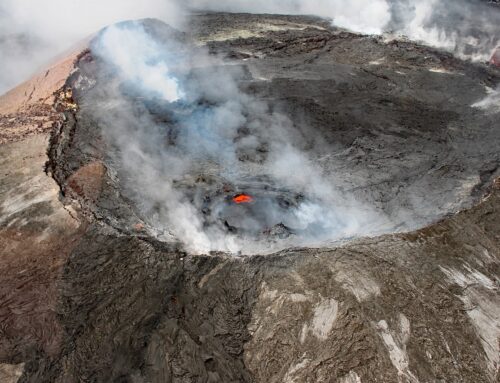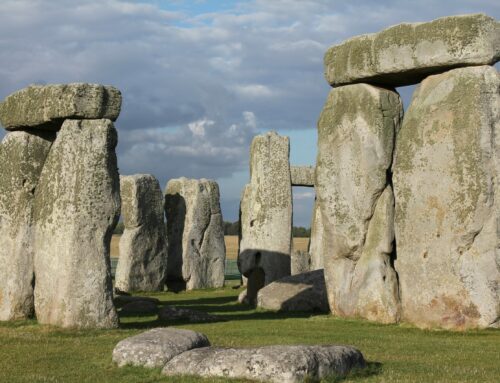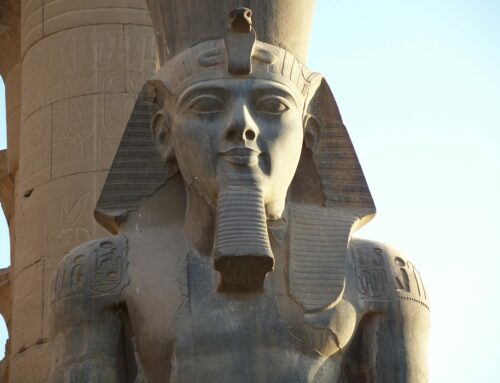Polynesians living on Easter Island (Rapa Nui) carved enormous stylized human figures known as moai thousands of years after ancient societies built the Stonehenge and Egyptian monuments. I am fascinated by the rocks and quarries where the ancient ones found and then shaped monolithic rocks, so I have written three blog posts about these topics. This is Part 3 – here are the links to Part 1 (Egypt) and Part 2 (Stonehenge).
The Moai of Easter Island (Rapa Nui)
Three volcanoes rose out of the sea to create Easter Island, or Rapa Nui, the Polynesian name for the island. The youngest of the three erupted around 200,000 years ago, and this lava covers about 95% of the surface of the island. Ancient Polynesian carvers created the enormous stylized human figures known as moai from blocks of volcanic rock between about 1250 and 1500 CE. Today, nearly 900 of these statues are on the island, much of which is designated as Rapa Nui National Park, and a UNESCO World Heritage Site. The name Easter Island was given by Jacob Roggeveen, the first European to discover the island who landed there on Easter Day, April 5, 1722.

Moais on Easter Island (Rapa Nui) (Wikimedia)
Visitors to Easter Island today can see moai in all stages of completion. Most of the moai range in height from about 15 to 20 feet tall (4.5 to 6 m) and weigh around 15 tons. Some were much larger—the tallest and heaviest that were erected reach almost 33 ft (10 m) high and weigh as much as 95 tons. Builders installed the statues on stone platforms, facing inland over the territory of the carvers. Around 300 of these platforms, called ahu, ring the coast of the island. The platforms are composed primarily of stone rubble, held in place by four stone retaining walls. In burials adjacent to many of the ahu are the remains of thousands of bodies that were cremated.
An Island of Volcanic Rocks
Volcanic rocks on the island were deposited under a variety of conditions, from eruptions that began deep in ocean waters to explosions on land. The rocks have a wide range of compositions and textures, from dark and dense, metal-rich basalts to light-colored, quartz-rich rhyolites. Polynesian carvers carefully selected the rock types best suited for their sculptures and bases. These rocks have high porosity, resulting from gas bubbles distributed throughout the hot material as it cooled, and all are easily workable. The low rock density was an important factor for the ancient sculptures, as other rocks on the island would have been difficult to work (e.g., the dense basaltic lavas, or friable tuffs that crumble easily). The ease of carving also makes the sculptures more erodible, so over the centuries, much of the original design details of carved symbols and even paint on the moai have been lost.
A volcanic crater named Rano Raraku near the eastern edge of the island is the quarry where laborers produced approximately 95% of the moai. The rocks in this quarry are lapilli tuff—solidified fragments of volcanic material that were ejected during an eruption and fell to earth while still partially molten—and they are ideal for carving. On the inner slope of Rano Raraku are dozens of upright, partially buried moa; the carvers may have planned for these to remain in permanent positions. Many moai in the quarry are incomplete and several are buried up to the shoulders in the spoil from the quarry work. Some seem to have been abandoned when partially finished after carvers reached areas of harder rock in the tuff. Others are on the slopes of the volcanic crater in places that are difficult to reach, or of much larger sizes and greater weights. One carving is 71 ft (21.6 m) long and possibly as much as 270 tons—far larger than any completed and erected moai. Throughout the quarry, the stone picks, drills, and hammers the carvers used to shape the sculptures remain where they were left by the workers.

Moais quarry at Rano Raraku (Wikimedia)
Late in the history of moai sculptures, carvers used a red volcanic rock for the headdresses, or chieftain topknot, and for the pupils in the eyes of some statues (white coral was also used to make the eyes). This rock is a red scoria—a cavity-filled (vesicular) glassy rock formed on the surface of lava flows when volcanic gases escaped before solidification. The headdresses are called pukao, and the red rock came from a quarry known as Puna Pau, which also contains unfinished pukao. These headdresses can weigh up to about 12 tons and were probably placed after the moai were upright.

Unfinish moai in the Rano Raraku quarry (Wikipedia)
Transporting the massive statues and erecting them on the shrines around the island is clearly a remarkable creative and physical feat. Traces of a hauling road leads out of the Rano Raraku crater, and roads that join it radiate outward toward the coasts, extending as far as 9 miles (14.5 km). Scattered along these roads are dozens of moai that were abandoned during transport.
Possible explanations for how workers moved the moai include rolling them on top of logs or on wooden sleds that laborers could pull on tracks. Recent experiments also show that is possible to literally “walk” the statues from the quarry to their ultimate positions by using rope harnesses and tilting the rock from side to side while pulling it forward.
The ancient people would have needed to use wood and fiber to assist in transporting the moai. Although the island was essentially deforested by the time Europeans arrived, pollen analysis shows that in the prior centuries, the island was almost totally covered by a subtropical forest of tall trees and woody bushes. Pollen analysis, fossil palm nuts, and casts of massive trunks and roots bundles show that formerly the island supported the largest palms in the world, some with trunk diameters exceeding 7 ft (2 m).
Regardless of how the Polynesians quarried and transported the hundreds of moai, the ancient Easter Islanders clearly had extraordinary engineering skills.

Moai lying on it’s back with man for scale, circa 1915 (Wikimedia)
If you liked this post, please share it and/or leave a comment or question below and I will reply – thanks! And if you’d like to receive a message when I publish a new post, scroll down to the bottom of this page, and leave your email address on my website. Join now to learn more about geology, geography, culture, and history.






Another thoughtful and informative treatment, Roseanne. I read Thor Heyerdahl’s Kontiki as a sophomore and am still fascinated as new information unfolds.
Thanks, Karen..